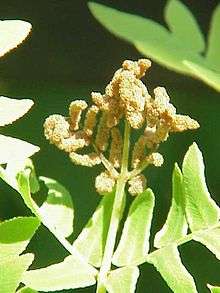Fern flower
The fern flower is a magic flower in Slavic mythology (Belarusian: папараць-кветка, Polish: kwiat paproci, Russian: цветок папоротника, Ukrainian: цвіт папороті) and in Baltic mythology (Lithuanian: paparčio žiedas, Latvian: papardes zieds), in Estonian mythology (Estonian: sõnajalaõis).

Tradition
According to the myth, this flower blooms for a very short time on the eve of the summer solstice (celebrated on June 21 or sometimes July 7) The flower brings fortune to the person who finds it. In various versions of the tale, the fern flower brings luck, wealth, or the ability to understand animal speech. However, the flower is closely guarded by evil spirits and anyone who finds the flower will have access to earthly riches, which have never benefited anyone, so the decision to pick the flower or leave it alone is left up to the individual.[1]
Slavic tradition
Russian, Ukrainian, Belarus and Polish tradition
r.gif)
In Russia, Ukraine, Belarus and Poland, the holiday is practiced on the eve of Ivan Kupala Day.[2] Young girls wear wreaths in their hair and couples go into the woods searching for the fern flower. When they come out of the woods, if the male is wearing the girl's wreath, it means the couple is engaged to be married.
According to folklore, the flower is chervona ruta. The flower is yellow, but according to legend, it turns red on the eve of Ivan Kupala Day.
Traditions in the Baltic and Nordic countries
Baltic and Estonian-Finnish tradition
In the Estonian, Lithuanian and Latvian tradition, the fern flower is supposed to appear only on the night of 23 to 24 June during the celebration of the summer solstice which is called Jāņi in Latvia, Joninės or Rasos in Lithuania, Jaaniõhtu or Jaaniöö in Estonia and juhannus in Finland. The celebration has pre-Christian origins.
Swedish tradition
Similar beliefs are attested in Sweden, where the fern flower was said to be found only at midnight on Midsummer's Eve, and even then was protected by magic and thus hard to obtain.[3] This also applied to horsetail and daphne flowers; of daphne, a flowering plant, it was said: "The flowers are a rarity if picked on nights when they are believed to bloom. The naturally occurring flowers no one believes to be daphne flowers."[note 1]
Blooming ferns

In fact, ferns are not flowering plants. However some experts think that the flowering fern myth has roots in reality. In the past, the grouping of plants was not as exact as modern taxonomic ones. Numerous flowering plants resemble ferns, or have fern-like foliage, and some of them indeed open flowers during night time.[4] Also, certain true ferns, e.g., Osmunda regalis have sporangia in tight clusters (termed "fertile fronds"), which may appear in flower-like clusters, and as a result, they are commonly known as "flowering ferns".
See also
- Blue Flower
- "St. John's Eve"
Notes
- "Blommor äro en raritet om de tagas de nätter de tros blomma. De blommor som äro naturliga tror ingen vara tibastblommor." Ericsson, Folklivet i Åkers och Rekarne härader, p. 251.
References
- "Paparčio žiedo legenda - būdas kiekvienam pasijusti herojumi". DELFI.lt. Retrieved 23 June 2011.
- Midsummer celebration (Celebration of Ivan Kupala Day)
- Ericsson, Gustaf (1992) [First published 1877-78]. Hellquist, Magdalena (ed.). Folklivet i Åkers och Rekarne härader [Everyday Life in the Districts of Åker and Rekarne] (PDF) (in Swedish). 3. Uppsala: The Institute of Dialect and Folklore Research. pp. 88, 176, 190. ISBN 978-91-85540-57-0. Retrieved 2017-11-01.
- "Saint John's Wreaths and Fern Flower" Archived 2007-09-30 at the Wayback Machine (in Polish)